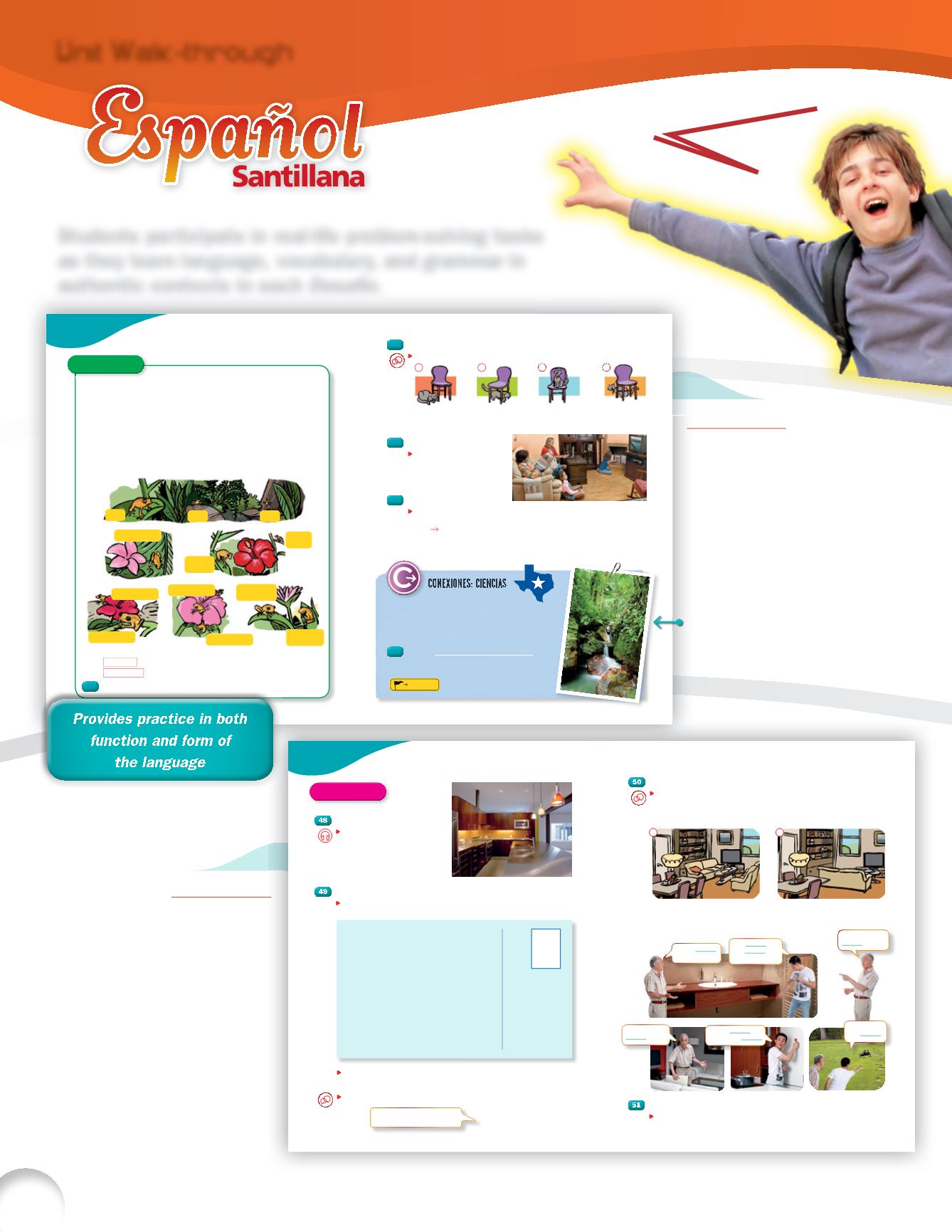

6
cientonueve 109
DESAFÍO 2
Expresar lugar
Gramática
Rememberthesecontractions:
a+ el=
al
Elcoquí está
al lado de
la flor.
de+ el=
del
Elcoquí está
encima del
libro.
43
Comparación.
What contractions are there in English? Are they optional or not?
45
¿Qué hay y dónde está?
Escribe.
Choose five things you see
in this photo and write sentences
indicating where each one is.
Use the verb
estar
.
Modelo
El televisor está lejosdel sofá.
46
¿Dónde está ahora?
Escribe.
Say where these things are right now. Be very specific.
Modelo
miCD favorito
MiCD favoritoestáenmi cuarto,encimademimesitadenoche.
1.
mi libro favorito
3.
mi cómoda
5.
mimesitadenoche
7.
mis cuadernos
2.
mi cama
4.
miarmario
6.
mis lápices
8.
misbolígrafos
El Yunque
En elnordeste
(northeast)
dePuertoRico estáElYunque,el
únicobosque
(forest)
tropicalen losparquesnacionales
de losEstadosUnidos.Allívivenmuchos coquíes
ymuchosanimalesyplantasdiferentes.
47
Piensa.
What kinds of animals might you find
in the National and State Parks in Texas?
What conditions do they need to survive?
TU DESAFÍO
Visit the website to view the flora
and fauna in El Yunque.
La construcción
estar en
r
To say where things are,use the verb
estar
followed by words that express place.
El coquí
está en el jardín
.
r
The preposition
en
expresses location. It is equivalent to the English words
at
,
in
,
on,
and
inside
.
El coquí está
en
la sala.
El coquí está
en
la estantería.
Adverbios y expresiones de lugar
r
Many other words and phrases are used to show location.
¿Dónde están los coquíes?
aquí
al ladode
la flor
cercade
la flor
lejosde
la flor
ahí
encimade
la flor
debajode
la flor
allí
a la izquierda
de
la flor
a laderecha
de
la flor
44
¿Dónde está el gato?
Habla.
Ask a partnerwhere the cat is ineachpic
Modelo
A.
¿Dónde está el gato en el dibujo 1?
B.
Elgato está a la izquierdade la silla.
1
2
detrásde
la flor
delantede
la flor
ture.
3
4
U
nit
W
alk-through
Students participate in real-life problem-solving tasks
as they learn language, vocabulary, and grammar in
authentic contexts in each
Desafío
.
SECTION 3
La gramática
(Grammar)
New grammar structures are
introduced and practiced along
with key vocabulary.
112 cientodoce
Comunicación
Escribe.
Now write a postcard to Marisa and describe a room in your home.
Describe everything it has and where each item is located. Include a photo
or make a drawing on the back.
Presenta.
Present your description to your classmates.
Modelo
La cocina de Ana García
Escucha.
Tim is talking to Andy about
Ana García’s kitchen. Listen to the five
statements and decide whether each
one is true
(cierto)
or false
(falso)
.
En el hotel
Lee y dibuja.
Tess is describing her hotel room in Puerto Rico to Marisa.
Read her description and use it to draw a picture or a floor plan of the room.
DESAFÍO 2
¡Hola,Marisa! ¿Cómo estás?
Mi hotel aquí en Puerto Rico está muy bien.
Mi cuarto está en el primer piso.Tiene una cama
grande y un sofá cerca de la
ventana.Eltelevisor
está encima de una mesa pequeña,delante del sofá.
El baño es magnífico: el inodoro, la bañera
y el lavabo son muy
modernos.Notengo cocina,
pero hay una mesa y un pequeño refrigerador.
Detrás del hotel,hay un jardín grande con mesas
y sillas. ¡Hay coquíes en el jardín!
¡Los coquíes son muy graciosos!
Hasta pronto.
Tess
Marisa Pérez
Avenida Morelia 23
Colonia Centro
Ciudad de México
México 45230
Micasaestáen…
Tiene…
ciento trece 113
Diferencias
Habla y escribe.
With a partner, find four differences between the rooms below.
Say and write the differences in Spanish.
Modelo
A.
En el dibujo 1,hay dos sofás.
B.
Y en el dibujo 2,hayuno.
¿Qué pasa en la historia?
Escribe y representa.
Fill in Tim and Mack’s dialogue for these scenes.
Some blanks may require more than one word. Then act out the dialogue.
Final del desafío
Sí.Ahíhayuno,
4
laducha.
Nohay coquíes
5
la sala.
¡Hayuncoquí
enel
8
!
1
2
¿Dónde
1
elcoquí?
Aquí
2
uno.
Está
3
lavabo.¿Haymás?
Hayuno
6
lapuertadel
7
.
SECTION 4
La comunicación
(Communication)
Communication activities are
progressively more open-ended,
allowing students to apply key
vocabulary and grammar in
communicative situations.
WHO WON!?
108
c
ientoo
cho
Students take on their own
cultural challenge through
Tu Desafío
activities.
U
nit
W
alk-through


















